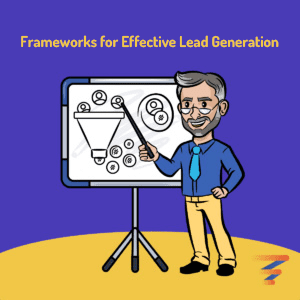Table of Contents
The Strategic Imperative: Why Lead Generation is Paramount
Beyond Tactics: Defining Strategic, Scalable Lead Generation
Building the Engine: Core Frameworks for B2B Lead Generation
Fueling the Engine: Aligning Sales and Marketing
Knowing Your Velocity: Lead Generation Metrics and Measurement
Quality Over Quantity: Improving Lead Quality
The Feedback Loop: Continuous Optimization and Adaptation
Download Our Advanced Guide
The Strategic Imperative: Why Lead Generation is Paramount
For sales and marketing leaders today, frameworks for effective lead generation are not simply helpful—they are mission-critical. Without a consistent and predictable stream of qualified leads, pipelines become volatile, sales forecasts lose accuracy, and growth targets slip further out of reach. This inconsistency affects not just marketing teams but cascades throughout the entire revenue organization, causing inefficiencies, wasted effort, and lost opportunities.
Many organizations struggle with fluctuating pipeline health, poor visibility into the real return on investment from lead generation activities, and a troubling disconnect between marketing and sales. Marketing may generate leads, but if those leads are not aligned with what sales needs or if the follow-up is delayed or ineffective, potential revenue slips through the cracks. As companies scale, these issues often compound, making ad-hoc campaigns and tactics insufficient for sustained success.
To overcome these challenges, sales and marketing leaders must elevate lead generation to a strategic priority with well-defined frameworks that support growth, improve alignment, and increase predictability. Effective frameworks serve as the backbone of a scalable, resilient revenue engine that drives consistent performance, enhances collaboration, and optimizes resource use across the organization.

Beyond Tactics: Defining Strategic, Scalable Lead Generation
Many businesses fall into the trap of chasing the latest lead generation tactics—running fragmented campaigns on different platforms or buying lists hoping for quick wins. While individual tactics may generate short-term activity, they rarely build sustainable momentum or deliver consistent, high-quality leads aligned with strategic objectives.
Strategic lead generation requires a holistic, scalable approach that integrates market understanding, targeted messaging, technology infrastructure, and cross-functional collaboration. It’s about designing and refining repeatable processes that reliably attract the right prospects, engage them meaningfully, and convert them into sales-qualified opportunities.
This means moving beyond siloed campaigns to develop a system that links marketing efforts with sales outcomes and customer success. The goal is to create a predictable lead pipeline that can be scaled efficiently while maintaining or improving lead quality. Leaders act as architects, engineers, and stewards—designing frameworks for effective lead generation that allow teams to operate with clarity, focus, and agility amid evolving market conditions.
Building the Engine: Core Frameworks for B2B Lead Generation
Ideal Customer Profile (ICP) and Buyer Personas
The cornerstone of effective lead generation frameworks is crystal-clear targeting through an Ideal Customer Profile (ICP) and detailed buyer personas. The ICP defines the ideal companies that gain the most value from your offerings and in turn provide strong lifetime value. This profile includes firmographic data like industry, company size, revenue, location, and can also incorporate technographic and behavioral criteria.
Buyer personas represent the decision-makers and influencers within those companies, fleshing out their roles, challenges, motivations, preferred communication channels, and buying triggers. These personas humanize your target market and help tailor messaging, content, and outreach.
Dynamic, regularly updated ICPs and personas are essential. They should be informed by ongoing data analysis from CRM systems, sales feedback, market research, and direct customer conversations. Without precise targeting, lead generation efforts scatter resources and result in wasted spend and poor lead quality.
Choosing the Right Channels and Strategies
Once the audience is defined, selecting the optimal mix of channels is critical. A balanced strategic approach blends inbound methods—like content marketing, SEO, and social media—with outbound activities such as prospecting and partnerships.
Content marketing attracts and educates prospects through blogs, whitepapers, webinars, and case studies, establishing thought leadership and building trust. SEO ensures your content is discoverable in search engines. Paid search and social media ads enable targeted outreach and remarketing to nurture prospects.
Email marketing nurtures leads through personalized communication sequences, while events and partnerships expand reach through direct engagement and mutual promotion. Outbound prospecting fills gaps by proactively identifying and engaging hard-to-reach leads.
Effective frameworks for effective lead generation prioritize channels based on their proven ability to deliver qualified leads, evaluating each not only on volume but on conversion quality and downstream impact.
Crafting Compelling Offers and Lead Magnets
Attracting attention is only the first step. To convert visitors into leads, compelling offers—lead magnets—must deliver real value aligned with prospects’ needs and decision stage. These may include ebooks, checklists, webinars, product demos, trials, or case studies.
Content must be strategically mapped to the buyer’s journey, providing education in awareness, addressing evaluation criteria in consideration, and supporting decision-making. Each lead magnet should have a clear call-to-action driving contact capture and engagement.
Well-crafted offers establish credibility and begin the qualification process by engaging prospects who are genuinely interested and ready to advance.
Implementing the Technology Stack
No modern lead generation framework succeeds without technology enabling scale and precision. Central to this is a CRM system that tracks every interaction, lead status, and pipeline stage, providing full visibility to sales and marketing leadership.
Marketing automation platforms complement the CRM by delivering personalized communications, automating workflows, scoring leads, and nurturing prospects over time. Integration between CRM and automation platforms ensures seamless data flow and coordinated engagement.
Investing in training and governance ensures consistent use and data quality, empowering teams to leverage insights and optimize campaigns continually.
Fueling the Engine: Aligning Sales and Marketing
Even the most sophisticated lead generation systems fail without strong alignment between sales and marketing. Strategic frameworks enforce collaboration through shared definitions, agreed lead qualification criteria, and service level agreements (SLAs).
Regular joint planning and review sessions promote transparency and collective ownership of results. Communication tools facilitate real-time updates on lead status and campaign feedback. Marketing enables sales with the right content, training, and tools to convert leads efficiently.
This alignment reduces lead leakage, accelerates follow-up, and maximizes conversion rates, creating a unified revenue growth engine.
Knowing Your Velocity: Lead Generation Metrics and Measurement
Measurement is foundational to managing and improving lead generation. Leaders focus on actionable metrics such as:
- Volume of leads, MQLs, and SQLs generated
- Cost per lead and cost per qualified lead
- Conversion rates at every funnel stage
- Average time for leads to progress between stages
- Customer acquisition cost (CAC) and ROI from campaigns
Dashboards visualize these metrics for quick insights, while deeper analysis identifies bottlenecks, high-performing channels, and areas to optimize spend.
A data-driven approach enables evidence-based decisions that refine and accelerate the lead engine’s performance.
Quality Over Quantity: Improving Lead Quality
High lead volume means little without quality. Frameworks for effective lead generation must include lead scoring systems that evaluate prospects based on firmographic data and engagement behavior, prioritizing those with the highest likelihood to convert.
Lead nurturing sequences deliver relevant content that educates and builds trust until leads are sales-ready. Sales feedback loops ensure continuous refinement of lead criteria and scoring models, aligning marketing efforts with real-world sales outcomes.
Focusing on quality increases sales efficiency, shortens cycles, and improves conversion rates.
The Feedback Loop: Continuous Optimization and Adaptation
Lead generation is an iterative process. Continuous improvement relies on A/B testing messaging, offers, and channels; regularly reviewing performance with sales and marketing teams; and auditing processes for efficiency.
Dynamic markets and evolving buyer behaviors require agile frameworks that adapt strategies, messaging, and tactics based on data and feedback.
This commitment to ongoing optimization keeps lead generation efforts relevant, effective, and aligned with business goals.
Download Our Advanced Guide
Ready to take your lead generation frameworks to the next level?
Download our Advanced Guide to B2B Lead Generation Strategies for in-depth tactics, templates, and case studies to build a predictable, scalable lead engine.
Useful Related Blogs from Sales Funnel Professor
- How Conversion Rate Experts Drive Revenue Growth & ROI
- Sales Funnel Building Skills
- Done For You Sales Funnel: Outsource for Faster Growth
- Growth Consulting Guide for Sales & Marketing Leaders
- B2B Sales Funnel Strategies & Examples
- What is ICP? A Guide to Creating Your Ideal Customer Profile
- Effective Lead Generation Frameworks for B2B Growth
- The Core Components of a Winning Marketing Strategy


